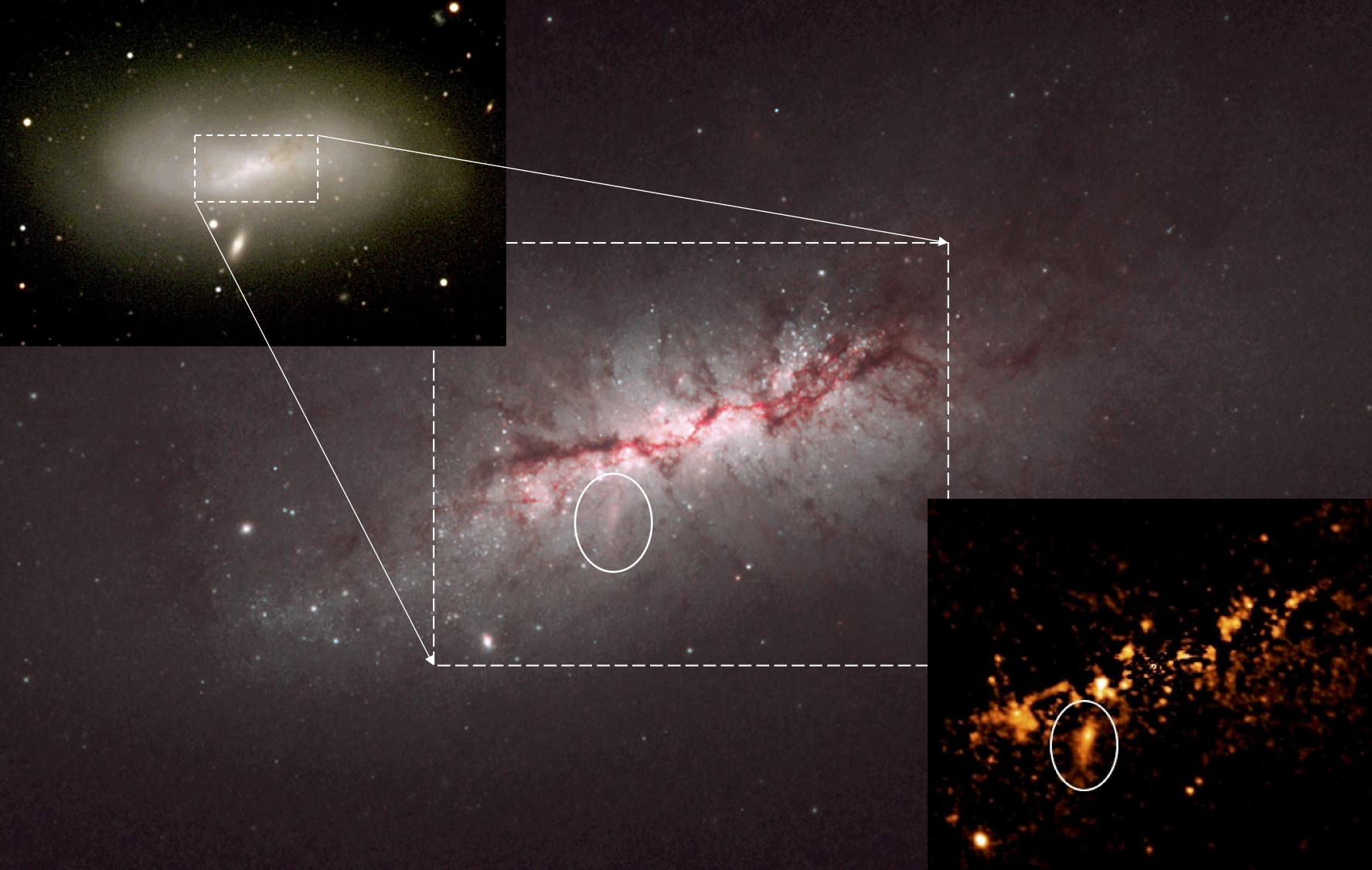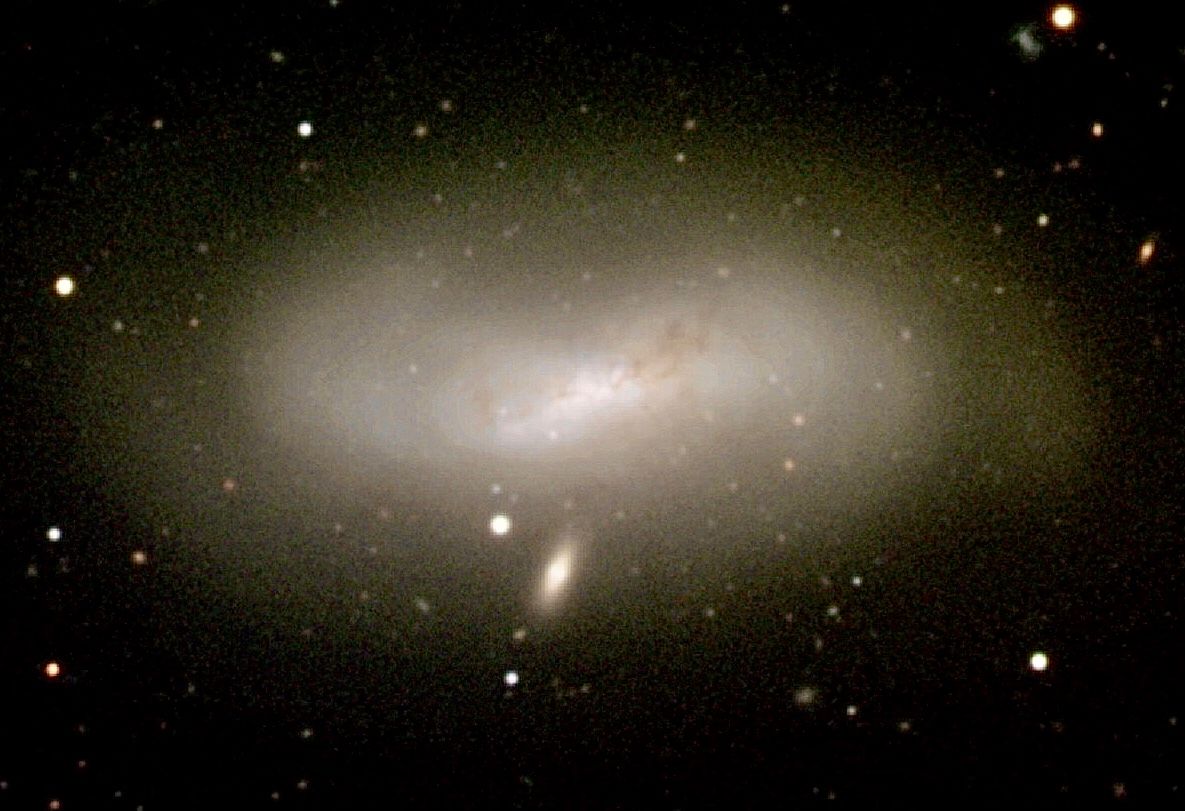A cosmic romance written in the stars

Researchers made the discovery in the inner region of a spiral galaxy (called galaxy NGC 4424), similar to our own – the Milky Way.
In summary
- An international team of astronomers has made a rare finding of what could be one of the largely missing population of “intermediate-mass” black holes
- The findings read like a cosmic romance written in the stars
- The discovery advances our understanding of how black holes come to be inside spiral galaxies
An international team of astronomers has taken a step forward in understanding the evolution of galaxies, and in so doing, told a story written in the heavens.
It has long been a mystery how some spiral galaxies obtained their central black hole. By combining visible and X-ray observations, astronomers have now discovered traces of what was probably once a small sphere-shaped galaxy, seen falling into a spiral galaxy and delivering what is thought to be the right-sized black hole.
The facts make for a cosmic romance, a similarity not lost on lead author of this new research, Professor Alister Graham, from Swinburne’s Centre for Astrophysics and Supercomputing and teaching into Swinburne Astronomy Online.
Galaxies can have mutual (gravitational) attraction for each other. The body of a smaller galaxy may fade over time, but its heart remains intact as it falls into and partners with a larger galaxy.
In this case, the heart is a million-strong cluster of stars, seen with the Hubble Space Telescope near the centre of the spiral galaxy NGC 4424.
NGC 4424 was already known to display signs of activity from a past merger event. Professor Graham says, “The galaxy’s bar-like structure is excited and buckled. There was also a star-forming event less than 500 million years ago. One can think of this as a star party of sorts, associated with the announcement of the upcoming galaxy wedding.”
However, he is quick to add that, "This appears to be an important discovery for understanding the coevolution of black holes and galaxies."

The astronomers were looking at galaxy NGC 4424, which was already known to display signs of activity from a past merger event, when they made the discovery. Image credit: WIYN Telescope, Juan R Cortes (ALMA).
A massive discovery
This is the first infalling galaxy found to have a massive black hole. The discovery contributes to our understanding of how black holes come to be inside spiral galaxies.
The astronomers have informally named the star cluster ‘Nikhuli’. They turned to the Sumi tribe in the Indian State of Nagaland for the word, used for a festive period where the descendants of head-hunters celebrate and wish for a rich harvest and gathering. It seemed appropriate to the astronomers, who refer to space as ‘the field’ and whose discovery focuses on how a larger galaxy has harvested a smaller galaxy.

Zoomed in images of galaxy NGC 4424 gave them a better view of the star cluster. Image credit: NASA/ESA, Or Graur (University of Portsmouth), Adam Riess (Johns Hopkins University), Lisa Frattare (Space Telescope Science Institute).
What the x-ray images show us
Professor Roberto Soria, a co-author at the Chinese Academy of Sciences, obtained a Chandra X-ray Observatory image showing a high-energy x-ray source emanating from the stretched-out star cluster seen in the Hubble image.
“We are likely seeing activity from around a black hole within what was the centrally-located star cluster of the infalling galaxy,” says Soria.
Although 50 million light-years away, each square metre of Earth is bathed in an x-ray from this active black hole roughly every 80 seconds. The X-ray hotspot is just 1300 light-years from the centre of NGC 4424, a galaxy some sixty thousand light-years across.
The main body of the smaller galaxy – which once housed the resilient star cluster – is now contributing to an inner `bulge’ of stars above and below the spiral galaxy’s disc, which contains the bar and spiral pattern.

Astronomers have circled the star cluster informally named Nikhuli. Image credit: NASA/ESA, Bogdan Ciambur (Paris Observatory), Alister Graham (Swinburne University of Technology).
Expanding our knowledge of the universe
The team’s best estimate for the mass of the black hole is seventy thousand times the mass of our Sun. This mass makes it a candidate for the largely missing population of “intermediate-mass” black holes with masses greater than stars and smaller than the supermassive black holes known to reside at the centres of giant galaxies, like M87 – which is often remembered as the famous first-ever image of a black hole, taken by the Event Horizon Telescope.
“This in itself is exciting,” says Graham. “Moreover, this mass is on par with that expected at the centre of NGC 4424.”
"We may be witnessing a supply mechanism for black holes into spiral galaxies," says Dr Ben Davis, a co-author at the New York University's campus in Abu Dhabi.
“Furthermore, potential collisions with other black holes make this an ideal setting for the emission of long-wavelength gravitational waves rippling across space,” says Davis.
The next step
Professor Graham, Professor Soria and Dr Davis are determined to find more infalling galaxies containing black holes in their drive to answer how black holes come to be within spiral galaxies.
Professor Graham and Dr Ben Davis are also members of the LISA Consortium, whose Laser Interferometer Space Antenna, aka LISA, and the Chinese TianQin (天琴计划) space missions are working towards discovering events involving the collision of big black holes.
Perhaps their future discoveries can be the romantic sequel, akin to something Sheldon from Big Bang Theory might have penned.
-
Media Enquiries
Related articles
-

- Astronomy
High school students work with Swinburne astronomers on the future of space
Swinburne’s Youth Space Innovation Challenge has inspired over 330 Australian teenagers to pursue a career in STEM.
Friday 26 July 2024 -

- Astronomy
- Science
Swinburne appoints new Director of Innovative Planet Research Institute
Leading geodesy expert, Professor Allison Kealy, has been appointed as the inaugural Director of Swinburne University's Innovative Planet Research Institute.
Monday 22 April 2024 -

- Astronomy
- University
OzGrav 2.0: A ‘new era of astrophysics’ launched at Swinburne
The next phase in the world-leading ARC Centre of Excellence for Gravitational Wave Discovery, dubbed 'OzGrav 2.0', launched this week at Swinburne University of Technology.
Wednesday 17 April 2024 -

- Design
- Astronomy
- Technology
- University
Swinburne ‘Rock Muncher’ takes part in Australian Rover Challenge
A multidisciplinary student team from Swinburne University of Technology competed in the 2024 Australian Rover Challenge held in Adelaide, South Australia.
Thursday 11 April 2024 -
.jpeg/_jcr_content/renditions/cq5dam.web.256.144.jpeg)
- Astronomy
New JWST observations reveal black holes rapidly shut off star formation in massive galaxies
New research showcases new observations from the James Webb Space Telescope that suggest black holes rapidly shut off star-formation in massive galaxies by explosively removing large amounts of gas...
Tuesday 23 April 2024

